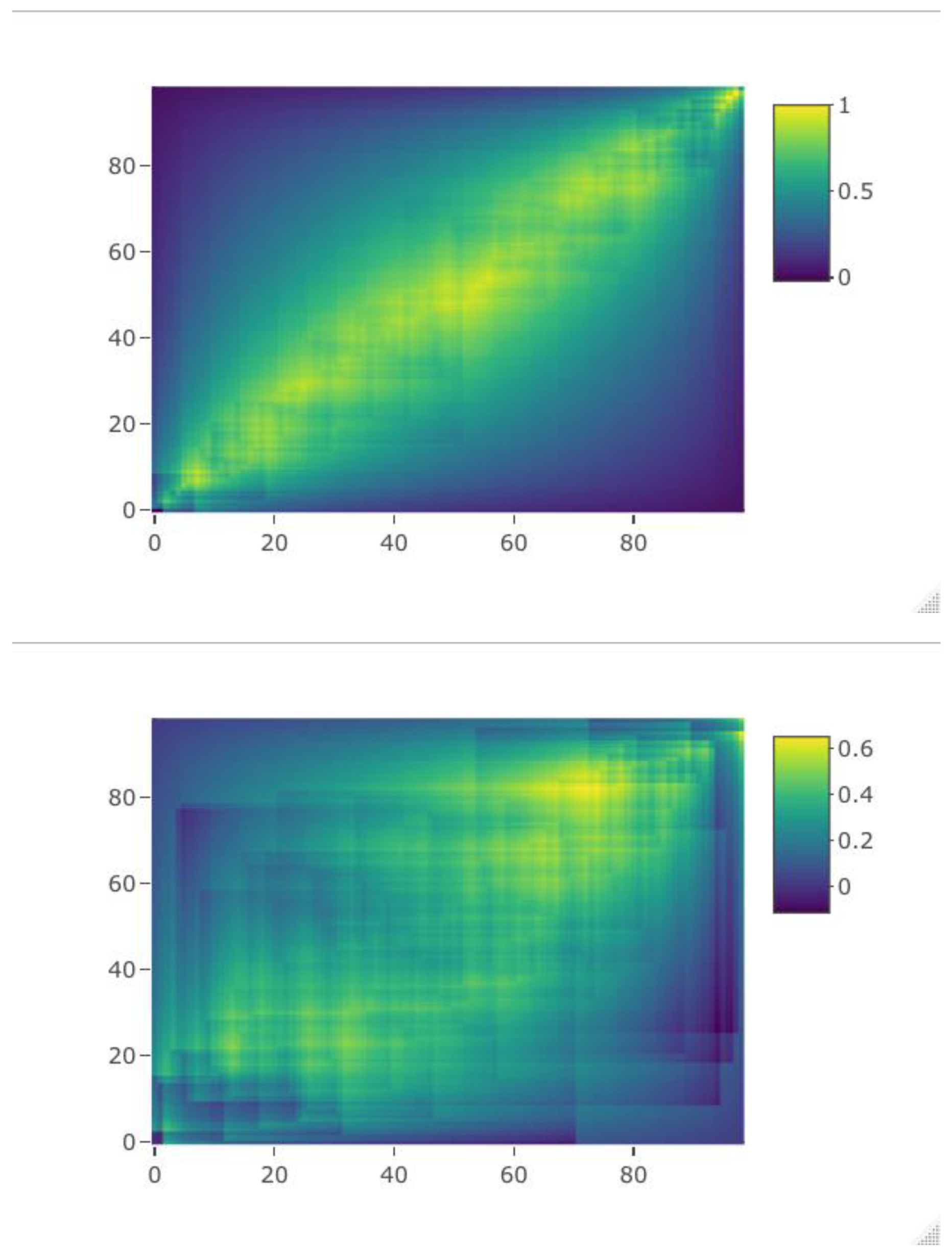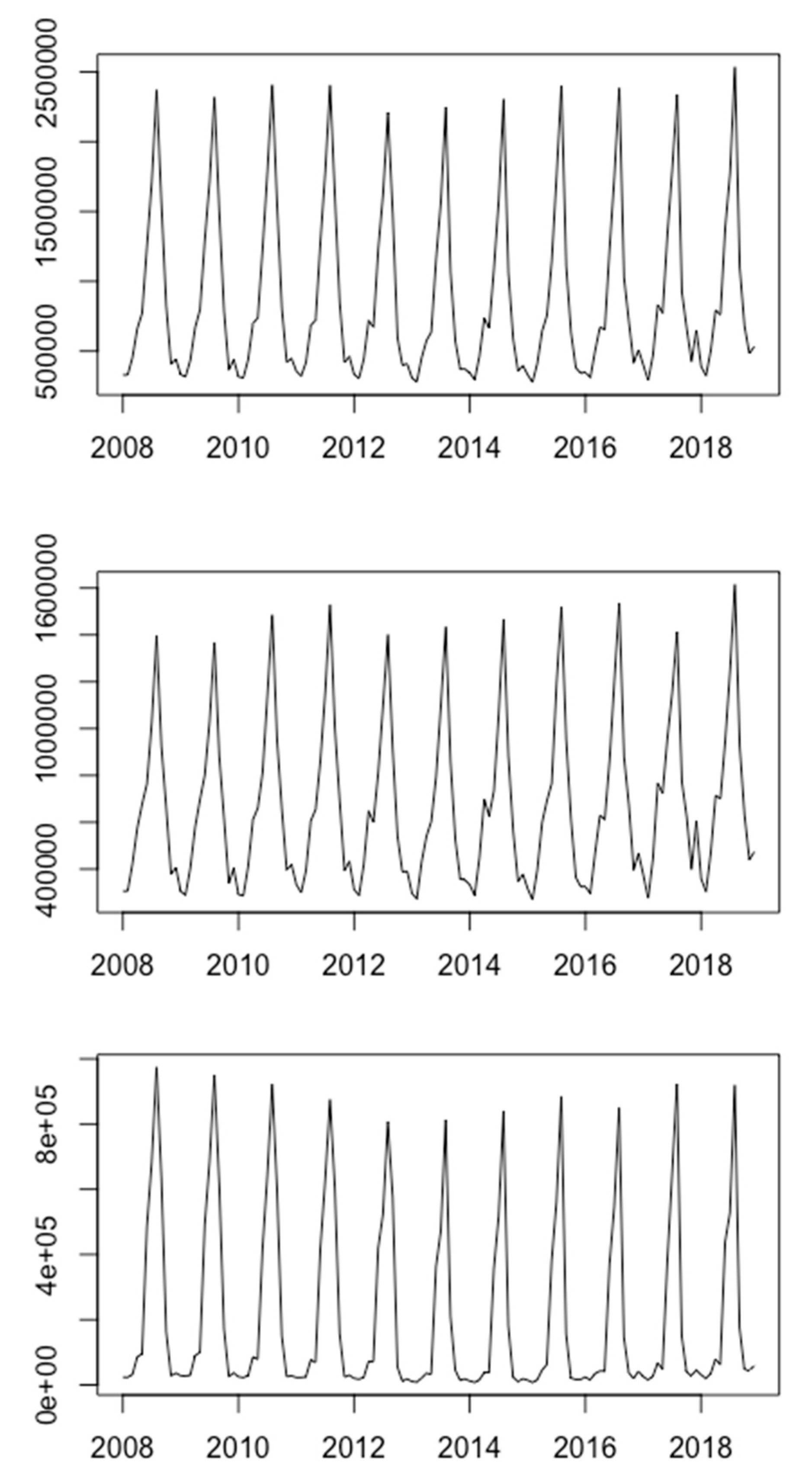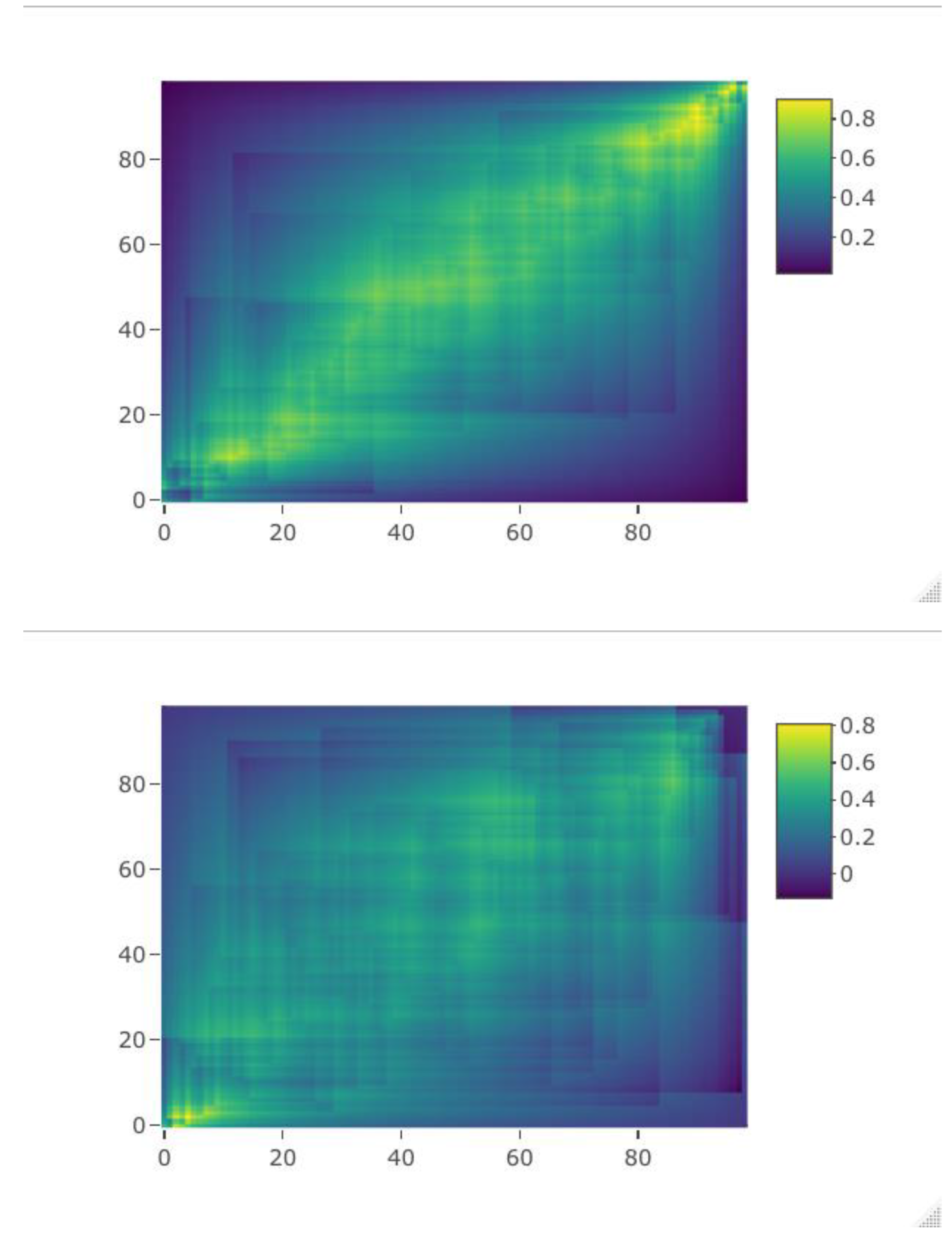Quantile Dependence in Tourism Demand Time Series: Evidence in the Southern Italy Market
Abstract
1. Introduction
2. Some Highlights on Tourism in Campania
3. Methodology
4. Results
4.1. Arrivals
4.2. Nights Spent
5. Discussion
6. Conclusions
Author Contributions
Funding
Conflicts of Interest
References
- World Tourism Organization. International Tourism Highlights; UNWTO: Madrid, Spain, 2019. [Google Scholar]
- Vodenska, M. Hospitality and Tourism in Transition in Central and Eastern Europe; Cambridge Scholars Publishing: Newcastle upon Tyne, UK, 2018. [Google Scholar]
- World Travel & Tourism Council. Travel & Tourism Economic Impact 2019; World Travel & Tourism Council: London, UK, 2019. [Google Scholar]
- Song, H.; Li, G. Tourism demand modelling and forecasting-A review of recent research. Tour. Manag. 2008, 29, 203–220. [Google Scholar] [CrossRef]
- Abedtalas, M.; Toprak, L. The determinants of tourism demand in Turkey. J. Econ. Behav. Stud. 2015, 7, 90–105. [Google Scholar] [CrossRef]
- Witt, S.F.; Witt, C.A. Modeling and Forecasting Demand in Tourism; Academic Press Ltd.: London, UK, 1992. [Google Scholar]
- Witt, S.F.; Song, H. Forecasting future tourism flows. In Tourism and Hospitality in the 21st Century; Lockwood, A., Medlik, S., Eds.; Butterworth-Heinemann: Oxford, UK, 2001. [Google Scholar]
- Zhang, M.; Li, J.; Pan, B.; Zhang, G. Weekly hotel occupancy forecasting of a tourism destination. Sustainability 2018, 10, 4351. [Google Scholar] [CrossRef]
- Yüksel, S. An integrated forecasting approach to hotel demand. Math. Comput. Model. 2007, 46, 1063–1070. [Google Scholar] [CrossRef]
- Assaker, G.; Esposito Vinzi, V.; ’O Connor, P. Structural equation modeling in tourism demand forecasting: A critical review. J. Travel Tour. Res. 2010, 1, 1–27. [Google Scholar]
- Premila Rosy, C.; Ponnusamy, R. Intelligent system to support judgmental business forecasting: Unconstraint hotel room demand in analytical hierarchy process. Int. J. Appl. Eng. Res. 2015, 10, 3079–3085. [Google Scholar]
- Zhang, B.; Pu, Y.; Wang, Y.; Li, J. Forecasting hotel accommodation demand based on LSTM model incorporating internet search index. Sustainability 2019, 11, 4708. [Google Scholar] [CrossRef]
- Chatziantoniou, I.; Degiannakis, S.; Eeckels, B.; Filis, G. Forecasting tourist arrivals using origin country macroeconomics. Appl. Econ. 2016, 48, 2571–2585. [Google Scholar] [CrossRef]
- Akin, M. A novel approach to model selection in tourism demand modeling. Tour. Manag. 2015, 48, 64–72. [Google Scholar] [CrossRef]
- Assaf, A.G.; Li, G.; Song, H.; Tsionas, M.G. Modeling and forecasting regional tourism demand using the Bayesian global Vector Autoregressive (BGVAR) model. J. Travel Res. 2019, 58, 383–397. [Google Scholar] [CrossRef]
- Huang, S.; Chen, G.; Luo, X.; Bao, J. Evolution of tourism research in China after the millennium: Changes in research themes, methods, and researchers. J. China Tour. Res. 2019, 15, 420–434. [Google Scholar] [CrossRef]
- Song, H.; Witt, S.F.; Li, G. The Advanced Econometrics of Tourism Demand; Routledge: New York, NY, USA, 2008. [Google Scholar]
- Dergiades, T.; Mavragani, E.; Pan, B. Trends and tourists’ arrivals: Emerging biases and proposed corrections. Tour. Manag. 2018, 66, 108–120. [Google Scholar] [CrossRef]
- Yu, Y.; Wang, Y.; Gao, S.; Tang, Z. Statistical Modeling and Prediction for Tourism Economy Using Dendritic Neural Network. Computational Intelligence and Neuroscience. 2017. Available online: https://www.hindawi.com/journals/cin/2017/7436948/ (accessed on 14 April 2020).
- Li, X.; Law, R. Forecasting tourism demand with decomposed search cycles. J. Travel Res. 2020, 59, 52–68. [Google Scholar] [CrossRef]
- Li, X.; Pan, B.; Law, R.; Huang, X. Forecasting tourism demand with composite search index. Tour. Manag. 2017, 59, 57–66. [Google Scholar] [CrossRef]
- Crouch, G.I. The study of international tourism demand: A review of practice. J. Travel Res. 1994, 33, 41–54. [Google Scholar] [CrossRef]
- Lim, C. An econometric classification and review of international tourism demand models. Tour. Econ. 1997, 3, 69–81. [Google Scholar] [CrossRef]
- Lim, C. Review of international tourism demand models. Ann. Tour. Res. 1997, 24, 835–849. [Google Scholar] [CrossRef]
- Lim, C. A meta analysis review of international tourism demand. J. Travel Res. 1999, 37, 273–284. [Google Scholar] [CrossRef]
- Goh, C.; Law, R. The methodological progress of tourism demand forecasting: A review of related literature. J. Travel Tour. Mark. 2011, 28, 296–317. [Google Scholar] [CrossRef]
- Wong, K.K.F.; Song, H.; Witt, S.F.; Wu, D.C. Tourism forecasting: To combine or not to combine? Tour. Manag. 2007, 28, 1068–1078. [Google Scholar] [CrossRef]
- Song, H.; Witt, S.F. Forecasting international tourist flows to Macau. Tour. Manag. 2006, 27, 214–224. [Google Scholar] [CrossRef]
- Witt, S.F.; Witt, C.A. Forecasting tourism demand: A review of empirical research. Int. J. Forecast. 1995, 11, 447–475. [Google Scholar] [CrossRef]
- Ouerfelli, C.; Abdellatif, A. Co-integration analysis of the central and eastern European tourism demand in Tunisia using non-stationary panel data. Athens J. Tour. 2008, 5, 97–1110. [Google Scholar] [CrossRef]
- Kulendran, N.; Divisekera, S. Measuring the economic impact of Australian tourism marketing expenditure. Tour. Econ. 2007, 13, 261–274. [Google Scholar] [CrossRef]
- Palmer, A.; Montano, J.J.; Sesé, A. Designing an artificial neural network for forecasting tourism time series. Tour. Manag. 2006, 27, 781–790. [Google Scholar] [CrossRef]
- Hadavandi, E.; Ghanbari, A.; Shahanaghi, K.; Abbasian-Naghneh, S. Tourist arrival forecasting by evolutionary fuzzy systems. Tour. Manag. 2011, 32, 1196–1203. [Google Scholar] [CrossRef]
- Pai, P.F.; Hung, K.C.; Lin, K.P. Tourism demand forecasting using novel hybrid system. Expert Syst. Appl. 2014, 41, 3691–3702. [Google Scholar] [CrossRef]
- Sun, X.; Sun, W.; Wang, J.; Zhang, Y.; Gao, Y. Using a Grey–Markov model optimized by Cuckoo search algorithm to forecast the annual foreign tourist arrivals to China. Tour. Manag. 2016, 52, 369–379. [Google Scholar] [CrossRef]
- Moorthy, R. An empirical analysis of demand factors for Malaysian tourism sector using stochastic methods. Rev. Integr. Bus. Econ. Res. 2014, 3, 255–267. [Google Scholar]
- Agiomirgianakis, G.; Sfakianakis, G. Explaining tourism inflows in Greece: A macroeconometric appproach. Int. J. Econ. Financ. 2016, 8, 192–197. [Google Scholar] [CrossRef]
- Mervar, A.; Payne, J.E. Analysis of foreign tourism demand for Croatian destinations: Long-run elasticity estimates. Tour. Econ. 2007, 13, 407–420. [Google Scholar] [CrossRef]
- Athanasopoulos, G.; Hyndman, R.J. Modelling and forecasting Australian domestic tourism. Tour. Manag. 2008, 29, 19–31. [Google Scholar] [CrossRef]
- Habibi, F.; Rahim, A.K.; Lee, C. United Kingdom and United States Tourism Demand for Malaysia: A cointegration Analysis. In Munich Personal RePEc Archive. 2008. Available online: https://mpra.ub.uni-muenchen.de/13590/1/MPRA_paper_13590.pdf (accessed on 14 April 2020).
- Hanly, P.; Wade, G. Modelling Tourism Demand–An Econometric Analysis of North American Tourist Expenditure in Ireland, 1985–2004. Tour. Econ. 2007, 13, 319–327. [Google Scholar] [CrossRef]
- Algieri, B. International tourism specialisation of small countries. Int. J. Tour. Res. 2006, 8, 1–12. [Google Scholar] [CrossRef]
- Chasapopoulos, P.; Den Butter, F.A.G.; Mihaylov, E. Demand for tourism in Greece: A panel data analysis using the gravity model. Int. J. Tour. Policy 2014, 5, 173–191. [Google Scholar] [CrossRef]
- Fiori, A.M.; Foroni, I. Reservation forecasting models for hospitality SMEs with a view to enhance their economic sustainability. Sustainability 2019, 11, 1274. [Google Scholar] [CrossRef]
- Linton, O.; Wang, Y.J. The quantilogram: With an application to evaluating directional predictability. J. Econom. 2007, 141, 250–282. [Google Scholar] [CrossRef]
- Han, H.; Linton, O.; Oka, T.; Whang, Y.J. The cross-quantilogram: Measuring quantile dependence and testing directional predictability between time series. J. Econom. 2016, 193, 251–270. [Google Scholar] [CrossRef]
- Baumöhl, E.; Lyócsa, S. Directional predictability from stock market sector indices to gold: A cross-quantilogram analysis. Financ. Res. Lett. 2017, 23, 152–164. [Google Scholar] [CrossRef]
- Todorova, N. The intraday directional predictability of large Australian stocks: A cross-quantilogram analysis. Econ. Model. 2017, 64, 221–230. [Google Scholar] [CrossRef]
- Shahzad, S.J.H.; Naifar, N.; Hammoudeh, S.; Roubaud, D. Directional predictability from oil market uncertainty to sovereign credit spreads of oil-exporting countries: Evidence from rolling windows and crossquantilogram analysis. Energy Econ. 2017, 68, 327–339. [Google Scholar] [CrossRef]
- Lyócsa, Š.; Vašaničová, P.; Litavcová, E. Quantile dependence of tourism activity between Southern European countries. Appl. Econ. Lett. 2020, 27, 206–212. [Google Scholar] [CrossRef]
- Shahzad, S.J.H.; Shahbaz, M.; Ferrer, R.; Kumar, R.R. Tourism-led growth hypothesis in the top ten tourist destinations: New evidence using the quantile-on-quantile approach. Tour. Manag. 2017, 60, 223–232. [Google Scholar] [CrossRef]
- Hardy, C.; Phillips, N.; Lawrence, T.B. Resources, knowledge and influence: The organizational effects of interorganizational collaboration. J. Manag. Stud. 2003, 40, 321–347. [Google Scholar] [CrossRef]








| Value Added (%) | Employed (%) | |
|---|---|---|
| Campania | 4.4 | 6.3 |
| South and Islands | 4.2 | 6.3 |
| Italy | 3.9 | 6.5 |
| Area | Value Added (%) | Employed (%) | Area | Value Added (%) | Employed (%) |
|---|---|---|---|---|---|
| Italy | 100 | 100 | Southern Italy | 100 | 100 |
| Abruzzo | 1.9 | 2.6 | Abruzzo | 7.6 | 8.2 |
| Apulia | 4.7 | 6.5 | Apulia | 19.3 | 20.5 |
| Basilicata | 0.6 | 0.8 | Basilicata | 2.4 | 2.5 |
| Calabria | 1.9 | 2.5 | Calabria | 7.8 | 8.0 |
| Campania | 7.0 | 8.7 | Campania | 28.6 | 27.6 |
| Molise | 0.3 | 0.5 | Molise | 1.4 | 1.6 |
| Sardinia | 2.9 | 3.5 | Sardinia | 11.9 | 11.0 |
| Sicily | 5.2 | 6.5 | Sicily | 21.0 | 20.6 |
| Hotels and Similar | Complementary Accommodations | Total Accommodations | ||||
|---|---|---|---|---|---|---|
| Number | Beds | Number | Beds | Number | Beds | |
| Change 2008–2018 (%) | 3 | 15 | 146 | 11 | 86 | 14 |
| Weight 2008 (%) | 42 | 58 | 58 | 42 | ||
| Weight 2018 (%) | 23 | 59 | 77 | 41 | ||
| Hotels and Similar | Complementary Accommodations | Total Accommodations | ||||
|---|---|---|---|---|---|---|
| Arrivals | Nights Spent | Arrivals | Nights Spent | Arrivals | Nights Spent | |
| Change 2008–2018 (%) | Residents and inbound | |||||
| 34 | 30 | 77 | −20 | 39 | 16 | |
| Residents | ||||||
| 15 | 13 | 46 | −25 | 19 | 1 | |
| Inbound | ||||||
| 66 | 55 | 120 | −12 | 74 | 37 | |
| Hotels and Similar | Complementary Accommodations | Total Accommodations | ||||
|---|---|---|---|---|---|---|
| Arrivals | Nights Spent | Arrivals | Nights Spent | Arrivals | Nights Spent | |
| Residents | ||||||
| Weight 2008 (%) | 64 | 59 | 59 | 61 | 63 | 59 |
| Weight 2018 (%) | 55 | 51 | 49 | 57 | 54 | 52 |
| Inbound | ||||||
| Weight 2008 (%) | 36 | 41 | 41 | 39 | 37 | 41 |
| Weight 2018 (%) | 45 | 49 | 51 | 43 | 46 | 48 |
© 2020 by the authors. Licensee MDPI, Basel, Switzerland. This article is an open access article distributed under the terms and conditions of the Creative Commons Attribution (CC BY) license (http://creativecommons.org/licenses/by/4.0/).
Share and Cite
De Luca, G.; Rosciano, M. Quantile Dependence in Tourism Demand Time Series: Evidence in the Southern Italy Market. Sustainability 2020, 12, 3243. https://doi.org/10.3390/su12083243
De Luca G, Rosciano M. Quantile Dependence in Tourism Demand Time Series: Evidence in the Southern Italy Market. Sustainability. 2020; 12(8):3243. https://doi.org/10.3390/su12083243
Chicago/Turabian StyleDe Luca, Giovanni, and Monica Rosciano. 2020. "Quantile Dependence in Tourism Demand Time Series: Evidence in the Southern Italy Market" Sustainability 12, no. 8: 3243. https://doi.org/10.3390/su12083243
APA StyleDe Luca, G., & Rosciano, M. (2020). Quantile Dependence in Tourism Demand Time Series: Evidence in the Southern Italy Market. Sustainability, 12(8), 3243. https://doi.org/10.3390/su12083243






